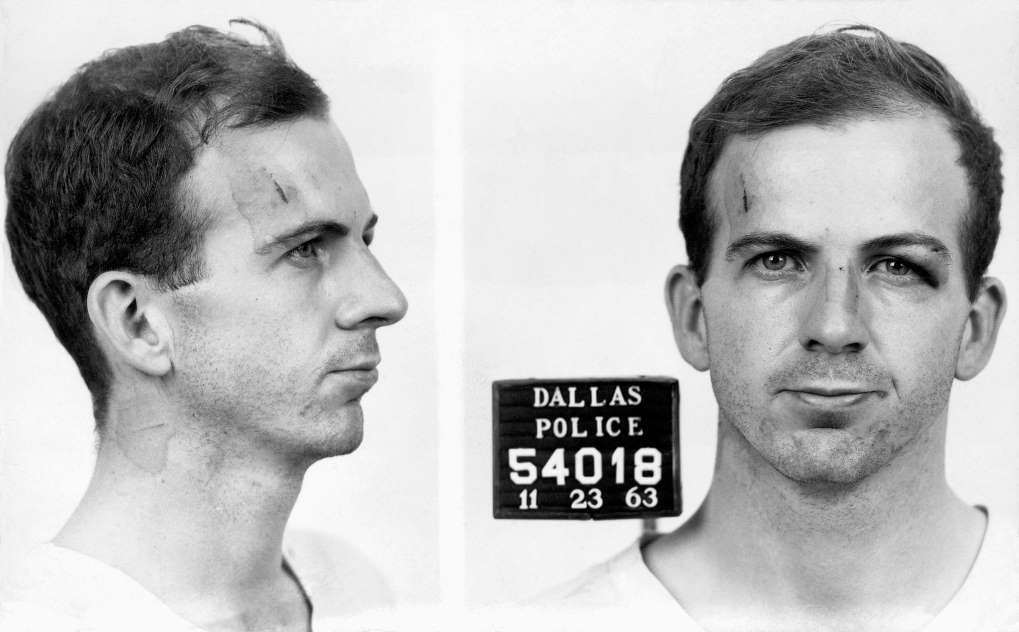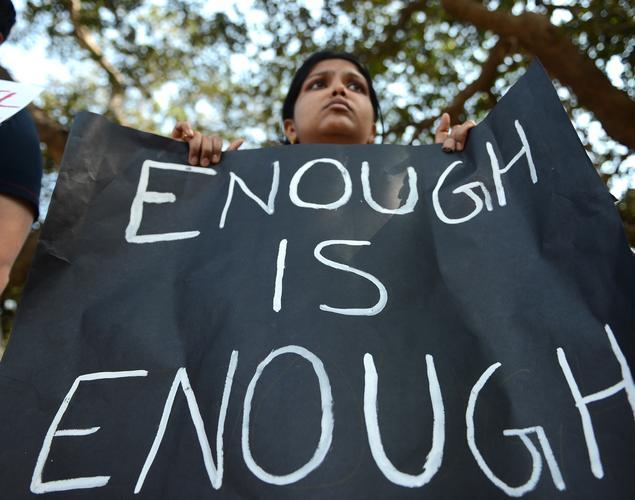October 27, 2017
WASHINGTON, D.C. — The vast trove of almost 3,000 new released files related to the Kennedy assassination includes letters between an associate of Lee Harvey Oswald and former CIA Director George H.W. Bush and a list of persons of interest in the case that includes Mafia figures, Cuban exiles and some of the men captured during the 1972 Watergate burglary.

October 27, 2017
WASHINGTON, D.C. — The vast trove of almost 3,000 new released files related to the Kennedy assassination includes letters between an associate of Lee Harvey Oswald and former CIA Director George H.W. Bush and a list of persons of interest in the case that includes Mafia figures, Cuban exiles and some of the men captured during the 1972 Watergate burglary.

Lee Harvey Oswald's mug shot after he was arrested on Nov. 22, 1963. – NONE, Police Department, City of Dallas/Courtesy Les Ellsworth via Newseum
They represent the spaghetti bowl of connections that link the assassination by Oswald of President John F. Kennedy on Nov. 22, 1963, with a series of Cold War intrigues that include the attempts to overthrow or kill Cuban dictator Fidel Castro, CIA-led assassination plots around the world and CIA and FBI spying on American citizens during the 1960s and 1970s.
On Friday, after President Trump approved the release of nearly 3,000 files related to the Kennedy assassination that has mystified Americans for more than five decades, researchers, historians, journalists and conspiracy buffs found detailed accounts of plots to kill Castro and musings from longtime FBI director J. Edgar Hoover.
The batch did not contain a "smoking gun" — the government still contends Oswald acted alone in killing Kennedy — it did contain alleged warnings that Kennedy would be targeted, and Oswald's visit to Mexico City two months before he shot the young president in Dallas.
More documents are coming.
While Trump had suggested that a final set of JFK assassination documents would be released, he withheld thousands of reports because government agencies — particularly the CIA and FBI — said they would undermine national security by revealing intelligence gathering and sourcing methods.
Trump tweeted Friday morning that he hoped to get all of the documents released.
Trump's decision to grant the wishes of the intelligence community to keep many of the documents sealed is "infuriating," said Gerald Posner, an expert on the Kennedy assassination and author of the 1993 book Case Closed, which determined Oswald acted on his own.
The longer the documents remain secret, Posner said on Fox News, "they're going to spawn all sort of new conspiracy theories."
University of Virginian political scientist Larry Sabato tweeted that the delay means more details will remain hidden.
White House spokeswoman Sarah Sanders said the remaining documents will be released with redactions proposed by the agencies in the coming weeks.
Saying that the public expects and deserves "as much access as possible" to investigative records, Trump authorized the release of almost 2,900 document files through the John F. Kennedy Assassination Records Collection Act of 1992.
The law, passed in the wake of Oliver Stone's conspiracy-minded film JFK, set Thursday as the final deadline.
Among the new information:
- Letters in 1976 between Bush, later the 41st president, and George de Mohrenschildt, an oil engineer who once knew Oswald in Texas. In a handwritten letter, de Mohrenschildt complained that publicity about his relationship with Oswald was upending his life. Bush responded, saying that an examination of CIA and FBI files indicated no "indication of interest in your activities on the part of the Federal authorities in recent years."
- A list of sources of persons of interest in the assassination investigation, including longtime Mafia figure Santo Trafficante, Cuban exiles and future Watergate burglars Bernard Barker and Frank Sturgis, and mobster Meyer Lansky, the inspiration for the character Hyman Roth in the Godfather: Part II.
- An Oct. 25, 1963, FBI document seeking information on Oswald's involvement in New Orleans with the pro-Castro "Fair Play for Cuba Committee." "Will maintain contact with Cuban sources for any indication of additional activity on the part of subject organization which appears to have become inactive since the departure from New Orleans of LEE HARVEY OSWALD," wrote FBI agent Warren De Brueys.
Oswald had been arrested for disturbing the peace in August 1963 while handing out "Fair Play for Cuba" leaflets in New Orleans. He moved to Dallas afterward. The document released Thursday had been released earlier; the new version revealed the identify of one of the FBI's Cuban informants in New Orleans.
- A 1975 “statement of facts” on assassination plots against Castro that began in 1959, shortly after he came to power. Detailing CIA contacts with Sam Giancana and other Mafia figures, the memo was written by the White House counsel for President Gerald Ford, a member of the Warren Commission that initially investigated the Kennedy assassination.
During that probe, the CIA withheld information about the Castro plots. While many conspiracy theories see the attempts to kill Castro as a motive to kill Kennedy, there is no evidence tying the Castro government to the assassination.
- Information tracking Oswald's movements in Mexico City in September 1963, two months before the assassination. One CIA handwritten document tracks Oswald’s contact with the Soviet Embassy in Mexico City, a nest of Cold War spies at the time.
Oswald once lived in the Soviet Union and expressed support for the Castro government, but no one knows why he visited Mexico City.
- Ledgers of payments to Cuban exile groups working to overthrow Castro's government.
- A Nov. 27, 1963, memo on a Secret Service interview with a man named Robert C. Rawls, who was in a bar in New Orleans a week to 10 days before the assassination and heard a man betting $100 that Kennedy would be dead within three weeks. Rawls, however, was drunk at the time and couldn’t remember the name of the man, what he looked like or what specific bar it was in.
- An FBI document on a claim that a British newspaper reporter received a call warning of a big event in the United States less than a half-hour before the assassination.
"The caller said only that the Cambridge News reporter should call the American Embassy in London for some big news and then hung up," the memo said, adding: "The important point is that the call was made, according to MI5 (British intelligence) calculations, about 25 minutes before the President was shot."
Many of the documents have been released in previous years, but had been heavily redacted with names and certain statements blacked out.
Researchers estimate that little more than 50 of the documents released Thursday night are new in full.
Conspiracy theorists had a field day,
Roger Stone, a long-time political adviser to Trump who wrote a book claiming that Vice President Lyndon Johnson was involved in the Kennedy assassination, cited a 1966 FBI memo claiming sources in the Soviet Union who also suspected Johnson, and feared that Moscow would be blamed for it. "Unsealed JFK documents show the KGB thought LBJ did it," Stone tweeted.
Legions of biographers and historians have said there is no evidence tying either Johnson or the Soviet Union to Kennedy's death.
In his memo authorizing the release of JFK assassination records, Trump said the American people should be "fully informed about all aspects of this pivotal event. Therefore, I am ordering today that the veil finally be lifted."
Given the concerns of the CIA and FBI, however, Trump said he had "no choice" but to allow withholding and redacting some documents "rather than allow potentially irreversible harm to our Nation's security."
These agencies now have 180 days to prove that withholding information is in the national security interest, officials said.
The newly released documents provide candid glimpses into the actions of public officials dealing the fallout from Kennedy's killing.
Hoover, the long-time and controversial FBI director, said in one memo that it was important for the government to demonstrate that Oswald did the murder, The memo is dated Nov. 24, 1963, the same day Dallas nightclub owner Jack Ruby shot and killed the gunman.
"There is nothing further on the Oswald case except that he is dead," Hoover wrote.
Courtesy/Source: USA Today
















































































































